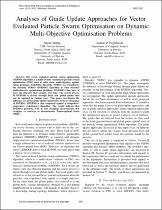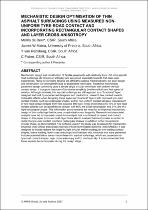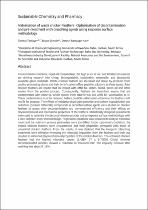JavaScript is disabled for your browser. Some features of this site may not work without it.
- ResearchSpace
- →
- Research Publications/Outputs
- →
- Book Chapters
- →
- View Item
| dc.contributor.author |
Greeff, M

|
|
| dc.contributor.author |
Engelbrecht, AP

|
|
| dc.date.accessioned | 2010-02-09T14:36:03Z | |
| dc.date.available | 2010-02-09T14:36:03Z | |
| dc.date.issued | 2010 | |
| dc.identifier.citation | Greeff, M and Engelbrecht, AP. 2009. Dynamic multi-objective optimisation using PSO. Studies in Computational Intelligence, (Series Ed: Kacprzyk, Janusz), pp 105-123 | en |
| dc.identifier.issn | 1860-949X | |
| dc.identifier.uri | http://www.springer.com/series/7092 | |
| dc.identifier.uri | http://hdl.handle.net/10204/3938 | |
| dc.description | Copyright: 2010 Springer. Part of Springer Science+Business Media. Permission to archive this author version is granted by Springer. Part of Springer Science+Business Media | en |
| dc.description.abstract | Optimisation problems occur in many situations and aspects of modern life. In reality, many of these problems are dynamic in nature, where changes can occur in the environment that influences the solutions of the optimisation problem. Many methods use a weighted average approach to the multiple objectives. However, generally a dynamic multi-objective optimisation problem (DMOOP) does not have a single solution. In many cases the objectives (or goals) are in conflict with one another, where an improvement in one objective leads to a worse solution for at least one of the other objectives. The set of solutions that can be found where no other solution is better for all the objectives is called the Pareto optimal front (POF) and the solutions are called non-dominated solutions. The goal when solving a DMOOP is not to find a single solution, but to find the POF. This chapter introduces the usage of the vector evaluated particle swarm optimiser (VEPSO) to solve DMOOPs. Every objective is solved by one swarm and the swarms share knowledge amongst each other about the objective that it is solving. Not much work has been done on using this approach in dynamic environments. This chapter discusses this approach, as well as the effect that various ways of transferring knowledge between the swarms, together with the population size and various response methods to a detected change, have on the performance of the algorithm. | en |
| dc.language.iso | en | en |
| dc.publisher | Springer. Part of Springer Science+Business Media | en |
| dc.subject | Dynamic multi-objective optimisation | en |
| dc.subject | Pareto optimal front | en |
| dc.subject | Vector evaluated particle swarm optimiser | en |
| dc.subject | Dynamic multi-objective optimisation problem | en |
| dc.subject | DMOOP | en |
| dc.subject | Particle swarm optimisation | en |
| dc.subject | PSO | en |
| dc.title | Dynamic multi-objective optimisation using PSO | en |
| dc.type | Book Chapter | en |
| dc.identifier.apacitation | Greeff, M., & Engelbrecht, A. (2010). Dynamic multi-Objective optimisation using PSO., <i></i> Springer. Part of Springer Science+Business Media. http://hdl.handle.net/10204/3938 | en_ZA |
| dc.identifier.chicagocitation | Greeff, M, and AP Engelbrecht. "Dynamic multi-objective optimisation using PSO" In <i></i>, n.p.: Springer. Part of Springer Science+Business Media. 2010. http://hdl.handle.net/10204/3938. | en_ZA |
| dc.identifier.vancouvercitation | Greeff M, Engelbrecht A. Dynamic multi-objective optimisation using PSO. [place unknown]: Springer. Part of Springer Science+Business Media; 2010. [cited yyyy month dd]. http://hdl.handle.net/10204/3938. | en_ZA |
| dc.identifier.ris | TY - Book Chapter AU - Greeff, M AU - Engelbrecht, AP AB - Optimisation problems occur in many situations and aspects of modern life. In reality, many of these problems are dynamic in nature, where changes can occur in the environment that influences the solutions of the optimisation problem. Many methods use a weighted average approach to the multiple objectives. However, generally a dynamic multi-objective optimisation problem (DMOOP) does not have a single solution. In many cases the objectives (or goals) are in conflict with one another, where an improvement in one objective leads to a worse solution for at least one of the other objectives. The set of solutions that can be found where no other solution is better for all the objectives is called the Pareto optimal front (POF) and the solutions are called non-dominated solutions. The goal when solving a DMOOP is not to find a single solution, but to find the POF. This chapter introduces the usage of the vector evaluated particle swarm optimiser (VEPSO) to solve DMOOPs. Every objective is solved by one swarm and the swarms share knowledge amongst each other about the objective that it is solving. Not much work has been done on using this approach in dynamic environments. This chapter discusses this approach, as well as the effect that various ways of transferring knowledge between the swarms, together with the population size and various response methods to a detected change, have on the performance of the algorithm. DA - 2010 DB - ResearchSpace DP - CSIR KW - Dynamic multi-objective optimisation KW - Pareto optimal front KW - Vector evaluated particle swarm optimiser KW - Dynamic multi-objective optimisation problem KW - DMOOP KW - Particle swarm optimisation KW - PSO LK - https://researchspace.csir.co.za PY - 2010 SM - 1860-949X T1 - Dynamic multi-objective optimisation using PSO TI - Dynamic multi-objective optimisation using PSO UR - http://hdl.handle.net/10204/3938 ER - | en_ZA |









